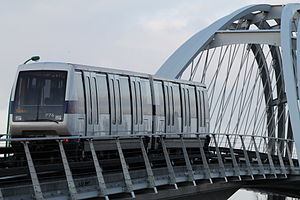Our website is made possible by displaying online advertisements to our visitors.
Please consider supporting us by disabling your ad blocker.
VAL 208
This article has multiple issues. Please help improve it or discuss these issues on the talk page. (Learn how and when to remove these messages)
|
| VAL 208 | |
|---|---|
 VAL 208 train on the Toulouse viaduct | |
| In service | 2001–present |
| Manufacturer | Siemens Mobility, Simmering-Graz-Pauker |
| Built at | Vienna, Austria |
| Family name | Véhicule Automatique Léger |
| Formation | 2 cars per trainset |
| Specifications | |
| Car body construction | Aluminium alloy |
| Car length | 13.07 m (42 ft 10+5⁄8 in) |
| Width | 2.08 m (6 ft 9+7⁄8 in) |
| Height | 3.27 m (10 ft 8+3⁄4 in)(without air conditioning) 3.7 m (12 ft 1+5⁄8 in)(with air conditioning) |
| Doors | 3 per side |
| Maximum speed | 80 km/h (50 mph) |
| Traction system | IGBT Chopper IGBT VVVF |
| Traction motors | 8 × MTS-14 65 kW (87 hp) brushless DC synchronous motor |
| Power output | 520 kW (700 hp) |
| Transmission | Parallel Cardan drive |
| Acceleration | 1.3 m/s2 (4.3 ft/s2) |
| Deceleration | 1.3 m/s2 (4.3 ft/s2) |
| Power supply | 750 V DC third rail |
| Bogies | SF-VAL208 |
| Safety system(s) | ATC (ATO) |
| Track gauge | 1,620 mm (5 ft 4 in) |
The VAL 208 is one of the VAL series, an automated guideway transit system developed by Matra and Siemens. The vehicles are manufactured at Siemens SGP (Simmering-Graz-Pauker) in Vienna, Austria.
It has been adopted by multiple railway operators since 2000.
The number 208 in the name comes from the fact that the width of the vehicle is 208 cm (6 ft 9+7⁄8 in).
In the successor to VAL 206, the system is compatible with VAL 206. Normally, automatic operation is performed, but it is possible for the driver to manually operate as necessary.
Previous Page Next Page


